What is a Trojan Horse? In the field of cybersecurity, this question has never been more critical. A Trojan Horse is not just a relic of Greek mythology; it’s a modern digital threat disguised as something harmless. Imagine downloading a free game or software update, only to discover it secretly opened the door to malicious activity. That’s the deceptive nature of this threat. Understanding it is essential because Trojans remain one of the most common and destructive forms of malware.
When I first started learning about online security, I was shocked to realize how easily people could be tricked. Unlike obvious viruses, a Trojan Horse blends in, waiting for the right moment to cause damage. Whether you’re protecting personal files or managing sensitive business data, awareness of this threat can save you from financial loss, identity theft, or worse. By learning its history, types, and uses, you’ll be equipped to face one of cybersecurity’s oldest enemies.
What is a Trojan Horse?

A Trojan Horse is malicious software that disguises itself as legitimate to trick users into installing it. Once inside a system, it can steal data, install additional malware, or even give attackers remote control. In cybersecurity, synonyms include “Trojan malware” or simply “Trojan.” Unlike worms or viruses, Trojans don’t spread on their own. Instead, they rely on social engineering, convincing users to download or execute them.
Breaking Down Trojan Horse
To fully understand what is a Trojan Horse, think of it like a gift-wrapped box hiding a dangerous surprise. On the outside, it looks appealing—a free app, a fake email attachment, or even a software patch. Inside, however, lurks malicious code waiting to execute.
Trojans usually enter systems through phishing emails, fake websites, or bundled software. Once activated, they can:
- Steal information such as passwords or bank details.
- Install backdoors that allow attackers to return anytime.
- Download additional malware like ransomware or spyware.
- Disrupt system performance or disable security defenses.
For example, you might receive an email that looks like a message from your bank. The attachment appears to be a secure document, but once opened, it installs a Trojan. From there, attackers could monitor your keystrokes, track your activities, or even use your machine to launch hacking attempts against others.
What makes a Trojan Horse so dangerous is its invisibility. Unlike obvious malware that crashes your system, a Trojan often stays hidden, carrying out silent attacks for weeks or months. That’s why many businesses pair firewalls with antivirus software and VPN tools like Express VPN to add multiple layers of protection. Without vigilance, even a Windows Update popup could be faked to lure you into installing one.
History of Trojan Horse
The name comes from the famous Greek myth, where warriors hid inside a wooden horse to infiltrate Troy. In the digital age, the metaphor remains powerful.
| Year | Event | Impact |
|---|---|---|
| 1970s | Early references in computing | Concept of hidden code introduced |
| 1980s | First real Trojan attacks | Spread via floppy disks |
| 1990s | Rise of internet Trojans | Fake emails and downloads |
| 2000s | Banking Trojans emerge | Targeted financial data |
| Today | Advanced Trojans use AI | Harder to detect, more destructive |
Types of Trojan Horse

There are several variations, each designed for specific malicious goals.
Backdoor Trojan
Creates a hidden entry point for attackers to control the system remotely.
Banking Trojan
Steals financial details like credit card numbers and online banking credentials.
Downloader Trojan
Installs other types of malware on the victim’s machine.
Rootkit Trojan
Hides its presence and other malicious files deep in the system.
| Type | Description | Target |
|---|---|---|
| Backdoor | Opens remote access | Any user |
| Banking | Steals financial info | Online banking |
| Downloader | Installs extra malware | General systems |
| Rootkit | Conceals malicious activity | Advanced targets |
How does Trojan Horse work?
A Trojan works by exploiting human trust. The user sees a legitimate-looking file or application, installs it, and unknowingly grants access. From that moment, the malicious code can operate silently in the background. Unlike worms that spread automatically, Trojans depend on deception. This reliance on trickery makes them one of the most effective tools for cybercriminals.
Pros & Cons
Although malicious, discussing their strengths and weaknesses helps us understand why they are effective.
Pros
Effective deception
Trojans are often disguised as legitimate software, email attachments, or links, tricking users into installing them unknowingly. This makes them one of the most deceptive forms of malware.
Can steal sensitive data
Once inside a system, Trojans can capture login credentials, credit card information, and other personal data. This stolen information is often sold on the dark web or used for fraud.
Allows remote control
Some Trojans open a “backdoor” into the victim’s device, giving attackers the ability to remotely control the system, install additional programs, or spy on activity.
Installs more malware
A Trojan doesn’t always act alone—it can download and install additional malicious software like ransomware, spyware, or keyloggers, making the infection even worse.
Cons
Hard to detect early
Because Trojans blend in with legitimate programs, many users don’t realize they’ve been infected until serious damage has already been done.
Can lead to identity theft
With access to personal details such as bank logins or social security numbers, victims may suffer from identity theft, which can take years to recover from.
System slowdown or crashes
Trojans often consume system resources or alter files, leading to slower performance, frequent crashes, or even complete device failure.
Financial and data loss
Beyond technical damage, victims can face stolen money, leaked personal information, or permanent loss of valuable files. Businesses in particular may also face reputational damage.
| Pros (for attackers) | Cons (for victims) |
|---|---|
| Effective deception | Hard to detect early |
| Can steal sensitive data | Can lead to identity theft |
| Allows remote control | System slowdown or crashes |
| Installs more malware | Financial and data loss |
Uses of Trojan Horse
Trojans are primarily used by cybercriminals to achieve various malicious goals.
Data Theft
One of the most common uses is stealing sensitive information like login credentials, banking details, and personal files.
System Control
Attackers may use Trojans to take control of a computer and use it for illegal activities, including launching distributed denial-of-service (DDoS) attacks.
Malware Delivery
Many Trojans act as delivery systems, silently installing ransomware, spyware, or adware.
Corporate Espionage
In business contexts, Trojans can be used for spying on competitors, stealing intellectual property, or sabotaging operations.
These uses highlight why cyber threats like Trojans remain among the most damaging. For example, a fake invoice email may seem harmless but could unleash spyware that spies on company secrets. Once, I accidentally clicked a suspicious file that turned out to be part of a Trojan campaign. Fortunately, my antivirus caught it, but many are not so lucky. This is why companies rely on security suites like Kaspersky to detect and stop malware, protecting against sophisticated programs such as deepfakes that exploit user mistakes.
By following these practices, you not only reduce the chances of infection but also strengthen your overall cybersecurity posture. Prevention is always more effective than recovery when it comes to Trojans.
Conclusion
The Trojan Horse remains one of the most enduring threats in cybersecurity because it preys on human trust and curiosity. While technology continues to evolve, the tactics of deception behind Trojans remain just as effective today as they were decades ago. From stealing sensitive data to enabling large-scale cyberattacks, these malicious programs show why vigilance, education, and layered security are essential. By recognizing how Trojans work, understanding their many forms, and practicing safe digital habits, individuals and organizations can turn awareness into defense. In the end, the Trojan Horse teaches us a timeless lesson: not everything that looks harmless can be trusted.
Resources
- Kaspersky – What is a Trojan Horse?
- Norton – Trojan Horse Malware Explained
- McAfee – Learn About Trojans
- Cisco – Malware Types: Trojans
- OWASP – Trojan Horse Definition
